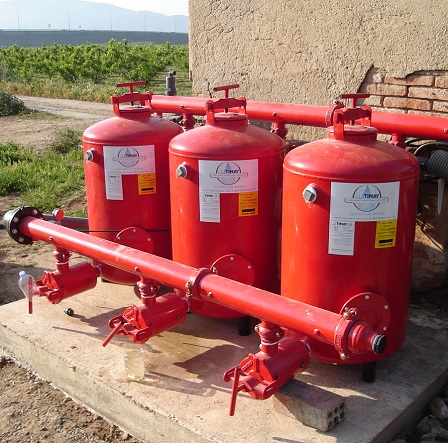Agricultural Irrigation
IRRIGATION INSTALLATIONS AND HYDRAULIC AUTOMATION SYSTEMS
Do you need to irrigate your vineyard, your fruit trees or your vegetable garden? I can help with the agronomic and hydraulic design (project) or directly with the installation. My specialty is drip irrigation (drop to drop), in vineyards, fruit trees or vegetable gardens.

IRRIGATION ENGINEERING – IRRIGATION PROJECTS
My name is Jacint Ponsa, I am an Agricultural Technical Engineer from the Barcelona School of Agriculture (ESAB) affiliated with the UPC. College number 3758.
My specialty is the agronomic design of agricultural irrigation (vineyards, fruit trees) or gardening (with lawns).
If you need to make a new irrigation installation for your vineyard or fruit trees, I can help you. I can also help you with irrigation automation: solenoid valves, programmers, climate sensors, water pumps. Ask me any questions or ask me for a quote.

PROGRAMMERS AND IRRIGATION AUTOMATION
The automation of agricultural irrigation will allow you to activate irrigation at night, considerably reducing evaporation. This small gesture can contribute to water savings of between 5 and 30%.
The automation of an irrigation consists of two elements: A solenoid valve and a programmer. The solenoid valve receives the electrical signal from the irrigation programmer. It works like a valve, therefore, it lets water pass or not according to the order received from the programmer.
There are many types, brands and sizes of programmers. In agriculture, they are used from small individual programmers (they open only one solenoid valve), to large devices capable of managing, apart from opening/closing individually, the cleaning of filters, and the application of fertilizer.

SAND FILTERS
If your irrigation water comes from an open pond, it will need to be filtered first. The best way to remove algae from the water is with a sand filter. If they are not removed, the drippers will be completely clogged in a few days and the irrigation will be completely unusable.
Sand filters must be metal if the working pressure of the irrigation is greater than 2.5bar. In drip irrigation and working at low pressure (<2.5bar), swimming pool type filters can be used (more economical).
It is highly recommended to program the cleaning of the filters in an automated manner.

DRIP IRRIGATION
Drip irrigation is the best and most efficient way to water your crop. Widely used in vineyards, fruit trees and vegetable gardens. It is also becoming popular with industrial crops such as tobacco, or even corn (bread).
In very long lengths of drip line, it is essential to use self-compensating drippers. These always deliver the same amount of water, regardless of the pressure received (within the working range of 0.7-2.5bar). If the drip line is not self-compensating, the first drippers (with more pressure), will discharge much more water and at the end of the line there may be no flow.
Drip irrigation should be planned minimally. It is necessary to evaluate, above all, what type of crop and what type of soil. If the soil contains, for example, clay, the water will have difficulty entering, but, on the other hand, there will be good horizontal circulation (wider bulb). On the contrary, with sandier soil, the water from the dripper will enter quickly, and by gravity it will form more elongated bulbs in the soil.
In vineyards, a drip line is placed directly on one of the tension wires. The drip line spacing varies from 60 to 120cm. In vineyards separated by 1.2m, it is usually placed with a separation of 60-75cm. In fruit trees, the ideal is to place two parallel lines, with a separation of 1.25-1.5m between drip lines.

RADIO SIGNAL FOR SOLENOID VALVES
Sometimes it is not possible to carry an electrical signal cable to open solenoid valves. In these cases, individual programmers (latch type batteries) or a radio opening system can be used.
The radio solenoid valve opening system consists of:
-Programmer: Can be any brand or model
-ICT Transmitter: Operates with 16-32 valves and expandable up to 512. Connects to the output of any conventional irrigation controller. Converts the 24Vac signal delivered to the controller into a coded signal and transmits it to the field receivers.
-Antenna 1/2 with coaxial cable for the ICT transmitter
-GAP field receivers: They receive the coded radio signal. There are two models. With 2 or 4 outputs (with lithium or alkaline battery). Decodes the signal and sends the opening/closing command to the solenoid valve in pulse format (latch).
